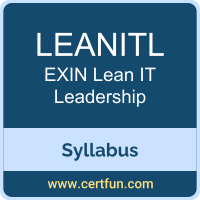 Use this quick start guide to collect all the information about EXIN LEANITL Certification exam. This study guide provides a list of objectives and resources that will help you prepare for items on the EXIN Lean IT Leadership (LEANITL) exam. The Sample Questions will help you identify the type and difficulty level of the questions and the Practice Exams will make you familiar with the format and environment of an exam. You should refer this guide carefully before attempting your actual EXIN Lean IT Leadership certification exam.
Use this quick start guide to collect all the information about EXIN LEANITL Certification exam. This study guide provides a list of objectives and resources that will help you prepare for items on the EXIN Lean IT Leadership (LEANITL) exam. The Sample Questions will help you identify the type and difficulty level of the questions and the Practice Exams will make you familiar with the format and environment of an exam. You should refer this guide carefully before attempting your actual EXIN Lean IT Leadership certification exam.
The EXIN LEANITL certification is mainly targeted to those candidates who want to build their career in Lean IT domain. The EXIN Lean IT Leadership exam verifies that the candidate possesses the fundamental knowledge and proven skills in the area of EXIN LEANITL.
EXIN LEANITL Exam Summary:
| Exam Name | EXIN Lean IT Leadership |
| Exam Code | LEANITL |
| Exam Price | $369 (USD) |
| Duration | 120 mins |
| Number of Questions | 60 |
| Passing Score | 65% |
| Schedule Exam | EXIN |
| Sample Questions | EXIN LEANITL Sample Questions |
| Practice Exam | EXIN LEANITL Certification Practice Exam |
EXIN LEANITL Exam Syllabus Topics:
| Topic | Details | Weights |
|---|---|---|
Lean Leadership - 9.9% |
||
|
Know the Key Components of Lean Leadership |
- Shingo Model: four key Guiding principles – Respect every individual, Lead with humility, Create constancy of purpose, Think systemically |
3.3% |
|
Understand the Following Aspects of Lean Leadership |
- Shingo Model Guiding and Supporting principles that directly impact on Lean Leadership |
3.3% |
|
Apply the Following Aspects Related to Lean Leadership |
- Use the comparison between Lean Leadership and Level 5 leadership (Collins) to identify differences |
3.3% |
Commit to Self-Development - 20% |
||
|
Know the Key Aspects of Commit to Self-Development |
- Self-development principles: Shu-Ha-Ri
- Leader Standard Work |
5% |
|
Understand the Following Aspects of Commit to Self-Development |
- Forms of standards in both IT work and IT leader work |
5% |
|
Apply the Following Aspects of Commit to Self-Development |
- Apply Shu-Ha-Ri to own situation |
10% |
Helping Others to Develop - 16.7% |
||
|
Know the Key Aspects of Helping Others to Develop |
- Definition of Genchi Genbutsu |
3.3% |
|
Understand of the Following Aspects of Helping Others to Develop |
- Importance of Lean IT Leadership in eliminating Mura and Muri |
5% |
|
Apply the Following Aspects of Helping Others to Develop |
- Use the 5 Why method (Exercise) - balancing Ask Why with Show Respect |
8.3% |
Continuous Improvement - 15% |
||
|
Know the Key Aspects of Continuous Improvement |
- Definition of continuous improvement |
3.3% |
|
Understand of the Following Aspects of Continuous Improvement |
- Difference between daily Kaizen and Kaizen event |
5% |
|
Apply the Following Aspects of Continuous Improvement |
- Describe the role of Continuous improvement within Lean IT |
6.7% |
Vision, Goals and Communication - 16.7% |
||
|
Know the Key Aspects of Vision, Goals and Communication |
- Performance dialogue: Leading meetings and Listening skills |
5% |
|
Understand the Following Aspects of Vision, Goals and Communication |
- Key characteristics of Hoshin Kanri |
3.3% |
|
Applying the Following Aspects of Vision, Goals and Communication |
- Create a vision for an IT organization |
8.3% |
Lean IT Transformation - 15% |
||
|
Know the Key Aspects of Lean IT Transformation |
- Basic components of the business case for a Lean IT transformation – Customer satisfaction, strategic advantages, cost advantages |
3.3% |
|
Understand the Following Aspects of Lean IT Transformation |
- 5 Lean IT Dimensions for structuring Lean IT Transformation |
5% |
|
Apply the Following Aspects of Lean IT Transformation |
- Plan and structure a Lean IT Transformation, using the 5 Lean IT Dimensions |
6.7% |
A3 Method - 6.7% |
||
|
List the Key Components of the A3 Method |
- Goals of the A3 Method |
1.7% |
|
Apply the A3 Method |
- Organize information into the A3 format |
5% |
To ensure success in EXIN LEANITL certification exam, we recommend authorized training course, practice test and hands-on experience to prepare for EXIN Lean IT Leadership (LEANITL) exam.
